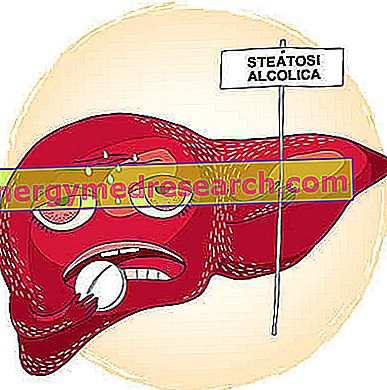Definition
Anal fissures are small but deep slits in the skin surrounding the anus; these annoying micro-cracks can generate pain associated with bleeding, which becomes more intense during the evacuation or following an effort. Hard and particularly voluminous stools can accentuate the problem, causing pain in the anal folds.
Causes
Anal fissures are extremely common in the elderly and newborns, although they can occur at any age; the alteration of intestinal motility, be it constipation or diarrhea, constitutes the etiological factor that most predisposes to the formation of anal fissures. In the elderly, this condition can be favored by the physiological decrease in the flow of blood in the affected area; again, anal fissures are quite common in women who have just given birth and in patients with Crohn's disease.
Symptoms
The signs and symptoms associated with anal fissures can include: pain during defecation, bloody stools, itching and anal irritation, difficulty in evacuation, constipation, more or less evident cuts in the perianal area.
Diet and Nutrition
Natural remedies
Information on anal fissures - drugs for the treatment of anal fissures is not intended to replace the direct relationship between health professional and patient. Always consult your doctor and / or specialist before taking Anal fissures - Medications for the treatment of anal fissures.
drugs
Fortunately, most of the time anal fissures are a pathological condition that can be resolved easily and quickly; in some patients, even fissures in the perianal area resolve without the need for pharmacological treatments or special treatments.
Clearly, anal fissures are not always so easy to cure; therefore, if the disorder persists, it is recommended to undertake a simple pharmacological treatment, as well as correct eating habits. The regularization of the diet seems to be a fundamental point to speed up the patient's recovery: a diet rich in fiber and plenty of water is certainly a valid aid to facilitate defecation, regulating intestinal motility.
Soaking in warm water several times a day is recommended: the heat of the water gives relief to the painful anal area, affected by fissures.
- Lidocaine (eg Xylocaina, Lidofast, Luan CHIR): it is a local application anesthetic, widely used in therapy to reduce pain associated with anal fissures and hemorrhoids. It is often formulated together with steroids such as hydrocostisone (eg Proctosedyl), useful for enhancing the anti-inflammatory effect. These drugs are particularly effective when the pain interferes with the physiological bowel movement.
- Psyllium seeds (Ex. Fibrolax): the product is a volume laxative, recommended in the case of anal fissures associated with constipation. It is recommended to take the drug orally, at a dose of 3.5 grams after meals, 2-3 times a day, for 2-3 days. Take the product with plenty of water in order to increase the fecal content. Do not continue the therapy beyond what is necessary.
- Nifedipine and lidocaine (eg. Antrolin): nifedipine-based rectal cream (pharmacological class: calcium channel blockers, useful for promoting a smoothing action of the peripheral smooth muscle) and lidocaine (local anesthetic) is indicated for the treatment of anal fissures : it is recommended to apply the drug 2 times a day for at least 6 weeks.
- Diltiazem (eg Cardizem) this active ingredient, like the previous one, belongs to the class of calcium channel blockers and is used in therapy for the treatment of anal fissures in association with local anesthetics or costisonics for topical application. Consult your doctor.
- Nitroglycerin (ointment at a concentration of 0.2-0.3-0.4%): apply a thin layer of cream to the skin affected by anal fissure, 2-3 times a day after thorough cleansing of the area. The therapy can also be continued for 6 months.
- Trinitroglycerin (eg Rectogesic): the drug (myorelaxant) is indicated to resolve pain associated with medium or severe entity anal fissures. Apply 1 cm of ointment (corresponding to approximately 375 mg of product, which contains 1.5 mg of active ingredient) in the perianal area every 12 hours; continue the therapy for no more than three weeks.
- Botulinum toxin (eg Botox, Vistabex, Bocouture, Xeomin): by injecting a small dose of botulinum toxin directly into the anal sphincter, a chemical denervation lasting a few months will be created, useful for relaxing the musculature. Botulinum toxin is injected into the internal and external sphincters; this treatment promotes healing from anal fissures.
If no attempt described above would benefit the patient suffering from anal fissures, the only possible option is surgery (ano-plastic, balloon dilation or lateral sphincterotomy); it is the duty of the physician to choose the most appropriate therapeutic option to ensure the patient's final recovery from anal fissures.



